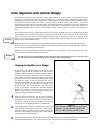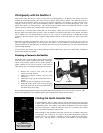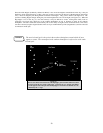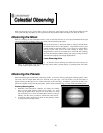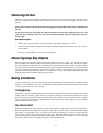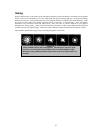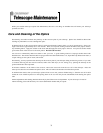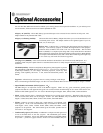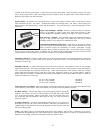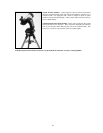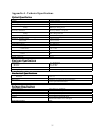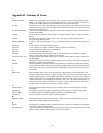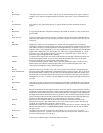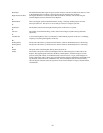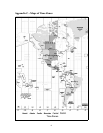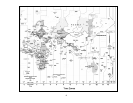
35
available in the following focal lengths: 2.5mm, 4mm, 5mm, 6mm, 9mm, 10mm, 12mm and 15mm. Celestron also offers
the LV Zoom eyepiece (#3777) with a focal length of 8mm to 24mm. It offers an apparent field of 40º at 24mm and 60º at
8mm. Eye relief ranges from 15mm to 19mm.
Eyepiece Filters - To enhance your visual observations of solar system objects, Celestron offers a wide range of colored
filters that thread into the 1-1/4" oculars. Available individually are: #12 deep yellow, #21 orange, #25 red, #58 green,
#80A light blue, #96 neutral density - 25%T, #96 neutral density - 13%T, and polarizing. These and other filters are also
sold in sets.
Night Vision Flashlight - (#93588) - Celestron’s premium model for astronomy,
using two red LED's to preserve night vision better than red filters or other
devices. Brightness is adjustable. Operates on a single 9 volt battery (included).
Red Astro Lite – (#93590) – An economical squeeze-type flashlight fitted with a
red cap to help preserve your night vision. Remove the red cap for normal
flashlight operation. Very compact size and handy key chain.
Light Pollution Reduction (LPR) Filter - These filters are designed to enhance
your views of deep sky astronomical objects when viewed from urban areas. LPR
Filters selectively reduce the transmission of certain wavelengths of light,
specifically those produced by artificial lights. This includes mercury and high
and low pressure sodium vapor lights. In addition, they also block unwanted natural light (sky glow) caused by neutral
oxygen emission in our atmosphere. Celestron offers a model for 1-1/4" eyepieces (#94126A).
Moon Filter (#94119-A) - Celestron’s Moon Filter is an economical eyepiece filter for reducing the brightness of the moon
and improving contrast, so greater detail can be observed on the lunar surface. The clear aperture is 21mm and the
transmission is about 18%.
Planisphere (#93720) - A simple and inexpensive tool for all levels of observers, from naked eye viewers to users of highly
sophisticated telescopes. The Celestron Planisphere makes it easy to locate stars for observing and is a great planet finder as
well. A map of the night sky, oriented by month and day, rotates within a depiction of the 24 hours of the day, to display
exactly which stars and planets will be visible at any given time. Ingeniously simple to use, yet quite effective. Made of
durable materials and coated for added protection. Celestron Planispheres come in three different models, to match the
latitude from which you’re observing:
For 20°
to 40° of latitude #93720-30
For 30
° to 50
°
of latitude #93720-40
For 40° to 60° of latitude #93720-50
Polarizing Filter Set (#93608) - The polarizing filter set limits the transmission of light to a specific plane, thus increasing
contrast between various objects. This is used primarily for terrestrial, lunar and planetary observing.
Sky Maps (#93722) - Celestron Sky Maps are the ideal teaching guide for learning the
night sky. You wouldn’t set off on a road trip without a road map, and you don’t need
to try to navigate the night sky without a map either. Even if you already know your
way around the major constellations, these maps can help you locate all kinds of
fascinating objects.
T-Adapter (#93635-A) - T-Adapter (with additional T-Ring) allows you to attach your
SLR camera to the rear cell of your Celestron NexStar. This turns your NexStar into a
1300mm telephoto lens perfect for terrestrial photography and short exposure lunar and
filtered solar photography.
T-Ring - The T-Ring couples your 35mm SLR camera body to the T-Adapter. This accessory is mandatory if you want to
do photography through the telescope. Each camera make (i.e., Minolta, Nikon, Pentax, etc.) has its own unique mount and
therefore, its own T-Ring. Celestron has 8 different models for 35mm cameras.



